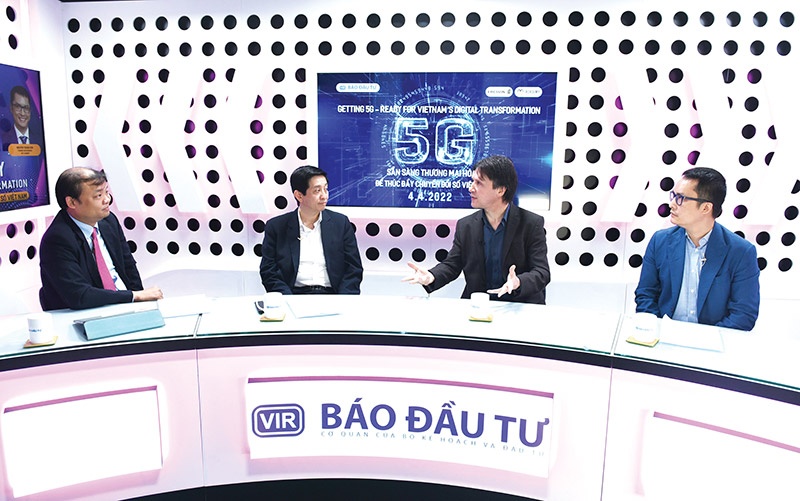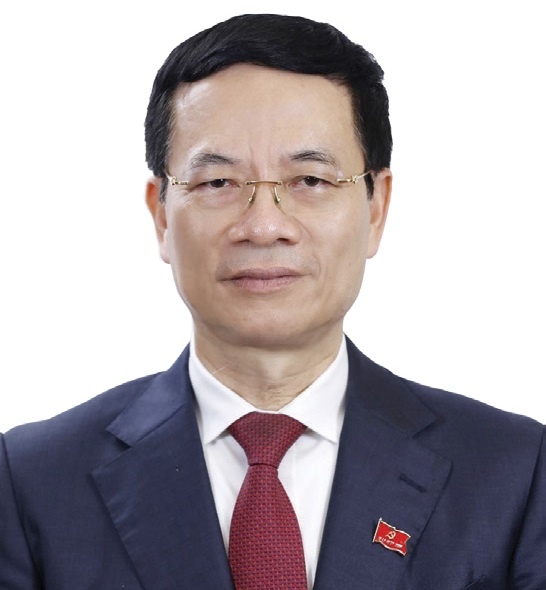Strengthening partnerships for efficient 5G networking
 |
| Experts and business leaders have been discussing exactly how Vietnam can tap into its big digital potential, Photo: Dung Minh |
At last week’s talk show on being 5G-ready for Vietnam’s digital transformation, hosted by VIR, Nguyen Hoa Cuong, vice president of the Central Institute of Economic Management (CIEM), said, “While we never talked about the implications for private sector development in the past with 2G and 3G, 5G is opening new doors for the business community, with the rise of nano-entrepreneurs and private enterprises. That’s because 5G is the enabler for many other technologies, besides being a technological innovation on its own.”
Business tie-ups are expected to be further strengthened in the months to come as some look to tap into the potential of 5G and make the network ready for the digital transformation of virtually any sector of industry or society, according to representatives from 5G industry leaders and policymakers at last week’s event.
Last year saw the establishment of some key partnerships for 5G. They include cooperation between Viettel, Ericsson, and Qualcomm to research, test, and successfully establish 5G data transmission speed of over 4.7Gbps. This is 40 times faster than 4G and twice as fast as currently available 5G speeds.
A partnership between RMIT and Ericsson for an education initiative on 5G in Vietnam is also in the works. Dedicated 5G networks can play an important role in the connectivity of higher education institutions as data demands grow, and the collaboration between universities and networking and telecommunications companies will help fast-track the process.
Having rich experience in digital transformation in the education sector, Nguyen Thanh Son, founder and chairman of MVV Academy, acknowledged this partnership represents an important step forward in the direction of building a future market-ready workforce in Vietnam. “Hopefully, this will also inspire other universities and schools to include 5G courses into their offering,” he noted.
MVV Academy also recently worked with AI testing company Genetica to deploy training for their professionals and got a glimpse of how a medtech-driven company investing in changing the mindsets of those working for them could make an impact on smarter healthcare.
VMware, meanwhile, has plans to leverage global partners including Nokia and Ericsson to share experience with local telco players in Vietnam. It also plans to work closely with industry partners and government bodies to build an open ecosystem for 5G and deliver solutions for enterprises to capitalise on cloud and 5G capabilities.
In 2020, the government approved the National Digital Transformation Programme for 2025 with a vision towards 2030. It called on all sectors to accelerate change and grab more involvement from the private sector.
For instance, the Ministry of Health initiated a partnership with the Ministry of Information and Communications (MIC) for digital transformation in the health sector, calling on private stakeholders such as IT businesses to contribute different technology solutions.
Similarly, insurance providers have long communicated about technology and digitalisation of processes and are actively contributing to the digitalisation of data and information when paying for healthcare services, according to speakers at last week’s talk show.
Elsewhere in the healthcare sector, pharmaceutical corporations have leveraged technology to roll out medical content hubs for healthcare professionals and the community, such as MedHub from Novartis, Smarthub by Pfizer, and A:Care from Abbott.
Central and larger public hospitals have also started digitalising their operations systems by diversifying payment options and implementing e-invoicing. In addition, robotic applications are becoming more popular in central-level hospitals.
To obtain the target of licensing 5G commercialisation in 2022, the MIC is taking bold moves. The government issued Decree No.88/2021/ND-CP last year on collecting fees for granting the right to use radio frequencies, auction, licensing, and transfer of the right to use radio frequencies for frequency bands. This is critical for auctioning and licensing 4G and 5G mobile bands, as well as removing bottlenecks in the legal framework for auctioning, licensing, and transferring radio frequency rights.
The MIC has also issued specific 5G standards on related base station equipment, communication terminal equipment, and the quality of Internet access services on 5G terrestrial mobile networks.
Cuong of CIEM elaborated that implementing 5G presents several challenges. These include infrastructure readiness, the time taken to provide services, and cost optimisation. “In fact, 5G has made a crucial contribution to our e-commerce, which plays an important role in Vietnam’s digital economy, and will continue to accelerate the development of other industries like AI, big data, and many others.”
Regarding enterprises’ investment in science, technology, and innovation, he added that they make up less than 1 per cent of revenues, which is low compared to ASEAN neighbours, with 9 per cent investment on average, or 30-50 per cent for countries like South Korea and Japan.
At the talk show, some valuable lessons Vietnam could learn from neighbouring countries were outlined. Son of MVV Academy suggested that the first is motivating all stakeholders from teachers and regulators to edtech companies and students. For instance, in Singapore, edtech companies would include content that motivates all their stakeholders in communication programmes, including gamification to motivate children or other users to learn.
The second is more flexibility in learning. In China, the Ministry of Education partnered with the Ministry of Industry and IT to mobilise society-wide resources for the provision of online courses and adopt flexible methodologies to facilitate learning through TVs or mobile apps, among others.
| Nguyen Manh Hung - Minister of Information and Communications
Over the past year, Vietnamese digital technology businesses have developed a number of platforms and applications. It is time for the country to boost the use and application among the people, as the ICT industry must be ready for new development in the re-opening era. This year, there is a special focus on increasing the number of people using digital platforms and applications, and generally on achieving breakthrough growth in the country’s digital economy. Then next year, the state will lead to creating new development breakthroughs. The ministry will assess the economic development of cities and provinces, sectors, and industries so as to ensure adjustments to timely accelerate the process. To gain success in digital transformation, localities should have a programme or plan showing the strong determination of leaders. At present, there are only three localities yet to have any plan or programme of this kind. This needs to be resolved as soon as possible. To accelerate digital transformation in cities and provinces, infrastructure must come first. Their tasks in 2022 are enabling points that 3G/4G cannot reach to have access; ensuring all households can access a single-board computer or smartphone; 80 per cent of households accessing cable-optic Internet; reducing 2G phones to fewer than 5 per cent; and increasing fixed and mobile Internet speeds to at least by 30 per cent. The prime minister and chairman of the National Committee on Digital Transformation has issued the national plan for 2022, in which tasks for each ministry and locality are set out. State investment in digital transformation has tended to increase among ministries and cities and provinces. Our ministry will develop an e-system with all ministries and provinces to supervise digital transformation investment projects, and is set to begin operation of this system in June. Vinod Joseph - Technical lead for Asia-Pacific & Japan, VMware
The latest announcement by the Vietnam government approving the digital economy development strategy, shows that the country is on track to accelerate its digital economy push. With its National Digital Transformation programme, Vietnam also plans to universalise broadband internet and 5G services, have 80 per cent of its population using e-payment, and become one of the 30 leading countries in the Global Cybersecurity Index. As a result of its plan for commercialising 5G technology in 2022 and expanding 5G coverage in urban areas and high-tech industrial zones, Vietnam has already taken a lead. As part of Vietnam’s National Digital Transformation Plan, the number of digital enterprises is estimated to increase from 58,000 to 100,000 by 2025, with the aim to build a digital government and economy, and eventually a digital society. Given this backdrop, there’s a huge opportunity that businesses can tap on as they respond, adapt, and accelerate to a digital-first economy. 5G is expected to provide a big push towards the various digital initiatives around industry 4.0. There are several key market opportunities, and the first is improved productivity. With smart farming gaining traction, with the help of advanced computing capabilities and the Internet of Things, 5G can extend geographic reach – be it of agricultural produce or improvement in production logistics and smart shipments. Next, as telecom companies build their networks, more communities will have access to 5G’s high speeds, larger capacity, and high reliability. In turn, 5G would enable better access to remote educational experiences with educational institutions being able to develop and deliver different kinds of learning content, such as live event streaming, via 5G. Third is advancement in healthcare. 5G in the healthcare industry can be utilised in many ways, such as analytics, patient monitoring, remote diagnostics, and robot-assisted surgery. Another prospect is better customer engagement for retailers. Through 5G connectivity, retailers can benefit from providing better customer engagement and personalised experiences. Smarter government management and services can also be achieved. Municipalities across the world are implementing a range of tech to create smart cities where buildings and other infrastructure and people are all connected so that everyone and everything can move as safely and smoothly as possible. Next up, and with governments across the world implementing a range of technologies to create smart cities where all the components are interconnected, a city can gather and analyse endpoint data about traffic flow and then use the results to route drivers around congested areas. 5G is essential to run a system with such a high volume of moving parts. The final market opportunity here is workforce empowerment. Here, 5G can help in delivering a much faster and more reliable connection that’s capable of not just supporting remote work but also delivering enough resiliency to support even mission-critical remote work, remote collaboration via AR, and other advanced technologies. Today, we see traditional network operators striking partnerships with the likes of AWS, Microsoft Azure, and Google Cloud. This new mood has been underpinned by important technology developments that may have given telcos confidence that they’re not going to be steamrollered or converged by what today looks like unstoppable cloud business growth. The last few years have seen the hyperscalers enhance abilities to host telcos’ network functions, both wireless and fixed, and assemble them into branded telecom infrastructure offerings. Google has Anthos for Telecom and Microsoft has Azure for Operators, with AWS having a range of technologies and alliances to make itself attractive to telco partners. 5G networks being built around the world are creating new services that will change the way we work and live. In this pervasive cloud world, telcos may have to deal with non-telco concepts like cloud-native, and similar hyperscalers understand there’s a huge degree of complexity in the telecom sphere. Service providers need to be able to modernise their network infrastructure quickly, simply and economically and the best way to do this is through a single platform that can automate and streamline delivery of multi-vendor network functions. This is where designing partnerships between telcos and hyperscalers to connect cloud-native applications come into play, building on each one’s individual strengths. The VMware Telco Cloud Platform enables service providers to rapidly deploy and efficiently operate multi-vendor Cloud-native Network Functions and Virtual Network Functions with agility and scalability across 5G and other networks that span from the core and the edge to the radio access network. Vaibhav Saxena - Former co-chair Indian Chamber of Commerce
Here, 5G will act as a catalyst to better support capacity building from the grassroots levels to rapidly-developing cities in Vietnam, and will accelerate overall capacity building for the country. The industry will see better connectivity with the globe as well as higher access to e-world resources for people of all ages. Tech not only updates the machinery or infrastructure, but it creates room for a more advanced future to bring the world closer in numerous aspects – from education and business to healthcare to administrative assistance, as well as communication among the world community. 5G will open the gates for several new opportunities to make living easier in the region. Digital transformation will, however, require adequate infrastructure. So, the country needs to be ready to connect machines, not only people. 5G will be the driver to provide high-speed data and communication access from villages to cities, and connect Vietnam with the world, creating a more sustainable ecosystem. Data flow is an important point, as is how to handle tech to combine with existing infrastructure and different bandwidths. Policy framework will also play a role as the key driver to enable tech implementation via a legal route. Perhaps industry players can be given a more active role through a special committee advising the government on a non-binding basis. Countries that are leading IT could also be involved and they can share their experiences so that Vietnam can build a strong policy and avoid the challenges already faced by different global players with offshore tech markets. |
What the stars mean:
★ Poor ★ ★ Promising ★★★ Good ★★★★ Very good ★★★★★ Exceptional
Themes: Digital Transformation
- BIM and ISO 19650 seen as key to improving project efficiency
- Viettel starts construction of semiconductor chip production plant
- Vietnam, UN strengthen cooperation in digital technology, AI
- Vietnamese firms win top honours at ASEAN Digital Awards
- ASEAN Digital Ministers' Meeting opens in Hanoi
Related Contents
Latest News
More News
- BIM and ISO 19650 seen as key to improving project efficiency (January 17, 2026 | 10:45)
- State sector sees broad-based profit surge as major groups deliver strong results (January 13, 2026 | 17:34)
- HSBC forecasts Vietnam's GDP growth to hit 6.7 per cent in 2026 (January 13, 2026 | 17:33)
- Japfa maintains position in top 10 animal feed firms (January 13, 2026 | 10:18)
- Roadmap shaping up to phase out gas bikes (January 13, 2026 | 10:07)
- FDI momentum accelerates transformation of Vietnam’s plastics sector (January 11, 2026 | 07:00)
- UOB lifts Vietnam growth outlook to 7.5 per cent for 2026 (January 10, 2026 | 09:00)
- Exports cement role as central pillar (January 09, 2026 | 12:37)
- Siemens and NVIDIA expand partnership to build industrial AI operating system (January 09, 2026 | 10:04)
- High targets, hard choices: companies weigh risks in 2026 (January 08, 2026 | 16:58)




 Tag:
Tag:




















 Mobile Version
Mobile Version